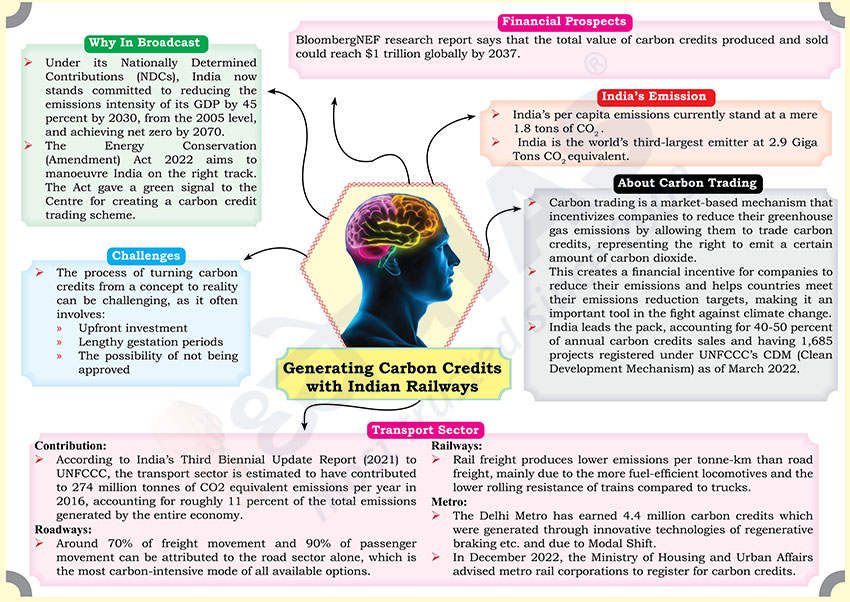Brain-booster /
17 May 2023
Brain Booster for UPSC & State PCS Examination (Topic: Generating Carbon Credits with Indian Railways)

Why in Broadcast?
- Under its Nationally Determined Contributions (NDCs), India now stands
committed to reducing the emissions intensity of its GDP by 45 percent by
2030, from the 2005 level, and achieving net zero by 2070.
- The Energy Conservation (Amendment) Act 2022 aims to manoeuvre India on
the right track. The Act gave a green signal to the Centre for creating a
carbon credit trading scheme.
Financial Prospects
- BloombergNEF research report says that the total value of carbon credits
produced and sold could reach $1 trillion globally by 2037.
India’s Emission
- India’s per capita emissions currently stand at a mere 1.8 tons of CO2 .
- India is the world’s third-largest emitter at 2.9 Giga Tons CO2
equivalent.
About Carbon Trading
- Carbon trading is a market-based mechanism that incentivizes companies
to reduce their greenhouse gas emissions by allowing them to trade carbon
credits, representing the right to emit a certain amount of carbon dioxide.
- This creates a financial incentive for companies to reduce their
emissions and helps countries meet their emissions reduction targets, making
it an important tool in the fight against climate change.
- India leads the pack, accounting for 40-50 percent of annual carbon
credits sales and having 1,685 projects registered under UNFCCC’s CDM (Clean
Development Mechanism) as of March 2022.
Transport Sector
Contribution:
- According to India’s Third Biennial Update Report (2021) to UNFCCC, the
transport sector is estimated to have contributed to 274 million tonnes of
CO2 equivalent emissions per year in 2016, accounting for roughly 11 percent
of the total emissions generated by the entire economy.
Roadways:
- Around 70% of freight movement and 90% of passenger movement can be
attributed to the road sector alone, which is the most carbon-intensive mode
of all available options.
Railways:
- Rail freight produces lower emissions per tonne-km than road freight,
mainly due to the more fuel-efficient locomotives and the lower rolling
resistance of trains compared to trucks.
Metro:
- The Delhi Metro has earned 4.4 million carbon credits which were
generated through innovative technologies of regenerative braking etc. and
due to Modal Shift.
- In December 2022, the Ministry of Housing and Urban Affairs advised
metro rail corporations to register for carbon credits.
Challenges
- The process of turning carbon credits from a concept to reality can be
challenging, as it often involves:
- Upfront investment
- Lengthy gestation periods
- The possibility of not being approved
























